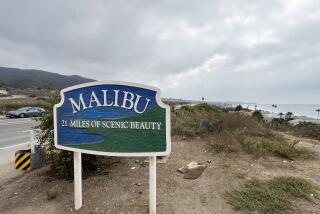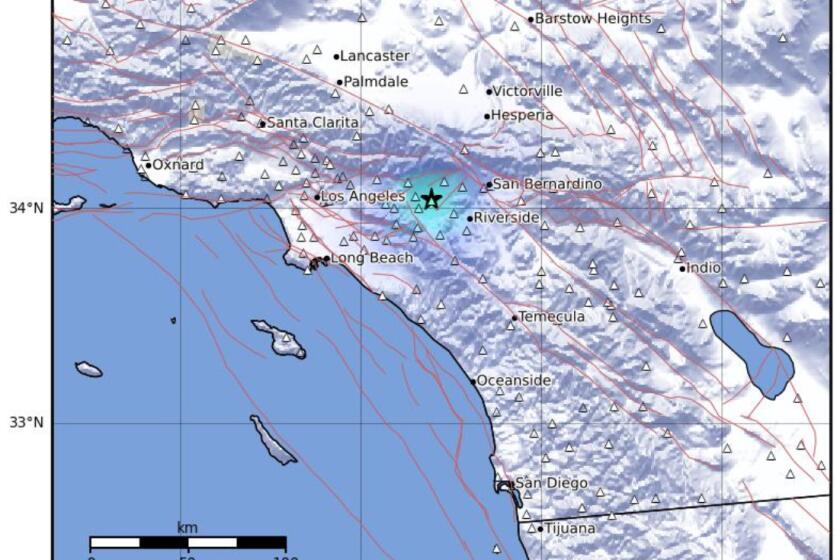Strange series of quakes sets Reno on edge
MOGUL, NEV. — An unusually intense swarm of earthquakes -- more than 1,000 over the last two months -- has struck beneath a small suburb of Reno, leaving residents shaken and scientists puzzling over the cause.
More than 20 quakes of magnitude 2 or higher have hit on some days, and the intensity and frequency of the quakes have been increasing rather than following the normal pattern of tailing off.
Although Nevada is the second-most seismically active state in the continental United States, researchers say they have never seen anything quite like the “Mogul earthquake sequence,” as they have named it.
“We don’t know what is going to happen next,” said geologist James Dolan of USC, who has been watching the unfolding seismic activity. But a swarm like this “makes you perk up your ears and start considering the possibility that you might be in a heightened period of hazard.”
The swarm of quakes has unnerved the roughly 3,000 residents who live around Mogul, a sparse community of ranch homes about two miles west of Reno.
“I lie in bed at night and I can feel” the quakes, said 72-year-old retired pressman Howard Seeman as he sipped a glass of white wine at Moxie’s, a neighborhood bar close to Mogul. “It’s scary, and you never know what is coming next.”
Still, with the biggest quake measuring a modest magnitude 4.7 and no significant damage or injuries resulting, residents are keeping their sense of humor about it. Some folks “are joking about moving to California to get away from the earthquakes,” Seeman said.
The Mogul sequence began Feb. 28 with a small tremor about a mile beneath the town. Over the following weeks, repeated small quakes struck the area.
About every third day or so, there would be a quake with a magnitude greater than 2 mixed in with the smaller temblors, said Nevada state geologist Jonathan Price.
A new pattern
The number of daily quakes grew slowly, and then a shift in the pattern occurred April 15, when magnitude 2 quakes began occurring about three times a day.
On April 24, the area suffered a magnitude 4.2 quake, and the number of magnitude 2 quakes, which are slight but noticeable, jumped to 20 a day or more, Price said. Before April 22, there had been more than 400 quakes. Last week alone, there were 500.
The biggest series of quakes struck Friday evening -- a magnitude 3.3 temblor, followed 11 seconds later by a magnitude 4.7, the strongest in the Reno area in more than half a century -- and then a 3.4 three minutes after that.
Normally, in an earthquake swarm, the main shock hits and then is followed by a series of ever smaller quakes. But this swarm “has been growing with time, which is actually quite unusual,” said geologist Brian Wernicke of Caltech. “I can’t think of any other example where that has happened.”
Earthquake swarms also usually occur much deeper, at least 5 miles below the surface and often much deeper than that. “It’s very, very rare to get earthquakes of any kind in the upper kilometer,” USC’s Dolan said.
Jean Frisk, 60, moved to Reno last August from the Bay Area, where she survived the Loma Prieta quake in 1989. Over a cup of coffee at Moxie’s, where virtually everyone was chattering about the swarm, the retired hardware store cashier said that she had never considered earthquake insurance while living in California.
But Friday’s 4.7 temblor, following all of the earlier quakes, so unnerved her that she went out first thing Monday morning and bought a policy.
Seeman said Friday’s quake had his ceiling fan swinging so hard that it was nearly banging the ceiling.
It’s the anticipation that is excruciating, he said. “With a hurricane or a tornado, at least you can see what is coming. But an earthquake sneaks up on you.”
Erwin Renz, 89, said Friday’s 4.7 made him decide to stockpile some earthquake supplies. Renz, who was walking his Labrador retriever Willie through the quiet streets of Mogul on Tuesday, said he went out and laid in stocks of canned fruit, vegetables, water and beer, “just in case.”
Swarms are usually associated with the movement of fluids, such as hot magma near a volcano or heated underground water.
Mammoth Mountain, for example, has frequent swarms related to the volcanic magma moving around under the mountain range. The Coso geothermal field on the China Lake Naval Air Weapons Station near Ridgecrest is famous for its swarms of small earthquakes associated with the underground hot water.
They aren’t “damaging earthquakes, just a large number of small events, and they go away” rather abruptly, Wernicke said.
Analogous situation
The closest analogy to the situation at Mogul is on the Tibetan plateau, which “is very prone to swarms of seismicity that go up to magnitude 4 or maybe 5,” he said. The swarms tend to be centered along a rift, an area where the Earth’s crust is being pulled apart as the massive tectonic plates move in opposite directions.
Because of that region’s political instability, researchers have been unable to study the quakes up close. “We don’t know a lot about them, except they are quite impressive as swarms,” Wernicke said.
In the Reno area, the Pacific tectonic plate is shearing away from the North American plate northward along the San Andreas fault hundreds of miles away, so that the Reno area is expanding in an east-west direction. That expansion could be the ultimate cause of the swarm, Wernicke said.
Whatever the source, earthquake experts are excited.
“It’s a great opportunity because it is so close to Reno and the Nevada Seismological Laboratory,” Price said.
The scientists are reluctant to make any predictions about what is going to happen in the days and weeks ahead.
Historically, there is a 2% chance that any earthquake is the foreshock of another one in the next 10 days with a magnitude one unit higher, and a 5% chance it is the foreshock of another one half a unit higher.
“We’ve beat both of those odds” with a magnitude 3 followed by a 4.2 and then a 4.7, Price said. “That’s a bit unusual, but not outlandishly unexpected. It’s like flipping a coin, and every now and then you get 10 heads in a row.”
Smaller faults
The good news, he added, is that the swarm is not associated with any named fault, which means that all of the faults in the immediate area are smaller ones. None of them have been associated with any big quake, he added.
But there’s no guarantee of safety. The 1992 magnitude-7.3 Landers earthquake centered in San Bernardino County, for example, occurred along five small faults similar to those in Reno, connecting the pieces to make one large quake, Dolan said.
--
ashley.powers@latimes.com
More to Read
Sign up for Essential California
The most important California stories and recommendations in your inbox every morning.
You may occasionally receive promotional content from the Los Angeles Times.










